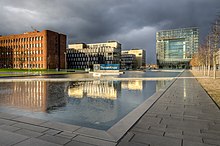
Back Friedrich Krupp AG German Krupp Greek Friedrich Krupp AG Esperanto Krupp (entreprise) French フリードリヒ・クルップAG Japanese Krupp (konsern) NB Friedrich Krupp (przedsiębiorstwo) Polish Krupp AG Portuguese Friedrich Krupp AG Hoesch-Krupp Russian Kruppkoncernen Swedish
You can help expand this article with text translated from the corresponding article in German. (May 2024) Click [show] for important translation instructions.
|
This article needs additional citations for verification. (June 2021) |
 | |
| Formerly | Friedrich Krupp AG (1968–1991) |
|---|---|
| Company type | Aktiengesellschaft |
| Industry | Conglomerate |
| Predecessor | Hoesch AG |
| Founded | 1587 in Essen, Germany |
| Founder | Friedrich Krupp |
| Defunct | 1999 |
| Fate | Merged with Thyssen AG |
| Successor | ThyssenKrupp |
Area served | Worldwide |
| Products | Steel, stainless products, automotive technologies, plant technologies, elevator systems, marine systems, shipbuilding, firearms |
| Owner | Alfried Krupp von Bohlen und Halbach Foundation |


Krupp, also known as Friedrich Krupp AG and later Friedrich Krupp AG Hoesch-Krupp after acquiring Hoesch AG in 1991, was the largest company in Europe at the beginning of the 20th century as well as Germany's premier weapons manufacturer during both world wars. From the Thirty Years' War to the end of World War II, it produced battleships, U-boats, tanks, howitzers, guns, utilities, and hundreds of other commodities. The company also produced steel used to build railroads in the United States and to cap the Chrysler Building.
After the Nazis seized power in Germany, Krupp supported the regime and was one of many German businesses that profited from slave labor during World War II. Upon the war's end, the head of the company, Alfried Krupp, was tried and convicted as a war criminal for employing prisoners of war, foreign civilians and concentration camp inmates under inhumane conditions in support of the Nazi war effort.[1] Despite being sentenced to imprisonment for twelve years, he served just three and was pardoned (but not acquitted) by John J. McCloy.[2] As a result of this pardon, all of Krupp's holdings were restored.[2]
In the years following the Third Reich's collapse, Krupp rose once again to become one of the wealthiest companies in Europe. However, this growth did not last indefinitely. In 1967, an economic recession resulted in significant financial losses for the business. In 1999, it merged with Thyssen AG to form the industrial conglomerate ThyssenKrupp AG.
Controversy has not eluded the Krupp company. Being a major weapons supplier to multiple sides throughout various conflicts, it was sometimes blamed for the wars themselves or the degree of carnage that ensued.[3][4]
- ^ Goldman, Stanely. "A Fuhrer of Industry: Krupp Before, During, and After Nuremberg". Loyola Marymount University and Loyola Law School. Archived from the original on 27 November 2020. Retrieved 15 January 2022.
- ^ a b "Alfried Krupp von Bohlen und Halbach | German industrialist". Britannica. 9 August 2023.
- ^ Taylor, Telford (2012). The Anatomy of the Nuremberg Trials: A Personal Memoir. Random House. p. 319. ISBN 9780307819819.
- ^ Michaelis, Kate Woodbridge; Michaelis, Otho E.; Monthaye, E. (2017). Alfred Krupp: a Sketch of His Life and Work: After the German of Victor Niemeyer. Abe Books. p. 31.
© MMXXIII Rich X Search. We shall prevail. All rights reserved. Rich X Search